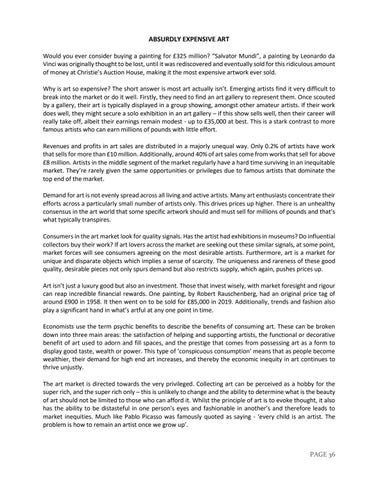ABSURDLY EXPENSIVE ART Would you ever consider buying a painting for £325 million? “Salvator Mundi”, a painting by Leonardo da Vinci was originally thought to be lost, until it was rediscovered and eventually sold for this ridiculous amount of money at Christie’s Auction House, making it the most expensive artwork ever sold. Why is art so expensive? The short answer is most art actually isn’t. Emerging artists find it very difficult to break into the market or do it well. Firstly, they need to find an art gallery to represent them. Once scouted by a gallery, their art is typically displayed in a group showing, amongst other amateur artists. If their work does well, they might secure a solo exhibition in an art gallery – if this show sells well, then their career will really take off, albeit their earnings remain modest - up to £35,000 at best. This is a stark contrast to more famous artists who can earn millions of pounds with little effort. Revenues and profits in art sales are distributed in a majorly unequal way. Only 0.2% of artists have work that sells for more than £10 million. Additionally, around 40% of art sales come from works that sell for above £8 million. Artists in the middle segment of the market regularly have a hard time surviving in an inequitable market. They’re rarely given the same opportunities or privileges due to famous artists that dominate the top end of the market. Demand for art is not evenly spread across all living and active artists. Many art enthusiasts concentrate their efforts across a particularly small number of artists only. This drives prices up higher. There is an unhealthy consensus in the art world that some specific artwork should and must sell for millions of pounds and that’s what typically transpires. Consumers in the art market look for quality signals. Has the artist had exhibitions in museums? Do influential collectors buy their work? If art lovers across the market are seeking out these similar signals, at some point, market forces will see consumers agreeing on the most desirable artists. Furthermore, art is a market for unique and disparate objects which implies a sense of scarcity. The uniqueness and rareness of these good quality, desirable pieces not only spurs demand but also restricts supply, which again, pushes prices up. Art isn’t just a luxury good but also an investment. Those that invest wisely, with market foresight and rigour can reap incredible financial rewards. One painting, by Robert Rauschenberg, had an original price tag of around £900 in 1958. It then went on to be sold for £85,000 in 2019. Additionally, trends and fashion also play a significant hand in what’s artful at any one point in time. Economists use the term psychic benefits to describe the benefits of consuming art. These can be broken down into three main areas: the satisfaction of helping and supporting artists, the functional or decorative benefit of art used to adorn and fill spaces, and the prestige that comes from possessing art as a form to display good taste, wealth or power. This type of ‘conspicuous consumption’ means that as people become wealthier, their demand for high end art increases, and thereby the economic inequity in art continues to thrive unjustly. The art market is directed towards the very privileged. Collecting art can be perceived as a hobby for the super rich, and the super rich only – this is unlikely to change and the ability to determine what is the beauty of art should not be limited to those who can afford it. Whilst the principle of art is to evoke thought, it also has the ability to be distasteful in one person's eyes and fashionable in another’s and therefore leads to market inequities. Much like Pablo Picasso was famously quoted as saying - ‘every child is an artist. The problem is how to remain an artist once we grow up’.
PAGE 36
